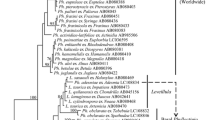Abstract
Powdery mildews in lowland central Burma were collected, identified and classified following a traditional taxonomic approach. They totalled 54 on 31 host-plant families and belonged to the genera Blumeria, Erysiphe (Uncinula), Golovinomyces, Leveillula, Phyllactinia, Podosphaera (Sphaerotheca), Oidiopsis and Oidium. A host index is included. Collections are held in Herbariums IMI and UC (=LAM) and also on deposit at the then Institute of Agriculture, Mandalay, Burma.
Similar content being viewed by others
References
Ahmad N, Sarbhoy AK, Agarwal K, Agarwal DK (2005) Five new anamorphic powdery mildews from India. Indian Phytopathology 58, 100–105.
Alvarez MG (1976) Primer catalogo de enfermedades de plantas Mexicanas. Fitofilo 71, 1–169.
Amano K (1986) ‘Host range and geographical distribution of the powdery mildew fungi.’ (Japan Scientific Society Press: Tokyo)
Blumer S (1967) ‘Echte Mehltaupilze (Erysiphaceae).’ (Gustav Fischer Verlag: Jena)
Braun U (1987) Amonograph of the Erysiphales (powdery mildews). Beiheft zur Nova Hedwigia 89, 1–700.
Braun U (1995) ‘The powdery mildews (Erysiphales) of Europe.’ (Gustav Fischer: New York)
Braun U (1998) ‘A monograph of Cercosporella, Ramularia and allied genera (Phytopathogenic hyphomycetes)’. Vol. 2. (IHW-Verlag: Echingby-Munich)
Braun U, Takamatsu S (2000) Phylogeny of Erysiphe, Microsphaera, Uncinula (Erysipheae) and Cystotheca, Podosphaera, Sphaerotheca (Cystotheceae) inferred from rDNA ITS sequences-some taxonomic consequences. Schlechtendalia 4, 1–33.
Braun U, Cook RTA, Inman AJ, Shin H-D (2002) The taxonomy of the powdery mildew fungi. In ‘The powdery mildews. A comprehensive treatise’. (Eds RR Bélanger, WR Bushnell, AJ Dick, TLW Carver) pp. 13–55. (American Phytopathological Society: St Paul, MN)
Butler EJ, Bisby GR (1931) ‘The fungi of India.’ (Government of India Central Publication Branch: Calcutta)
Carmichael JW, Kendrick WB, Conners IL, Sigler L (1980) ‘Genera of Hyphomycetes.’ (University of Alberta Press: Edmonton)
Castellani E, Ciferri R (1937) ‘Prodromus mycoflorae Africae orientalis Italicae.’ (Istituto Agricolo Coloniale Italiano: Firenze)
Cook RTA, Inman AJ, Billings C (1997) Identification and classification of powdery mildew anamorphs, using light and scanning electron microscopy and host range data. Mycological Research 101, 975–1002. doi: 10.1017/S095375629700364X
Crous PW, Phillips AJL, Baxter AP (2000) ‘Phytopathogenic fungi from South Africa.’ (University of Stellenbosch, Department of Plant Pathology Press: Stellenbosch)
Farr DF, Bills GF, Chamuris GP, Rossman AY (1989) ‘Fungi on plant and plant products in the United States.’ (American Phytopathological Society: St Paul, MN)
Glawe DA (2003) First report of powdery mildew of Nandina domestica caused by Microsphaera berberidis (Erysiphe berberidis) in the Pacific Northwest. Online. Plant Health Progress http://www.plantmanagementnetwork.org/pub/php/brief/2003/nandina doi: 10.1094/PHP-2003-1023-01-HN [verified 28 July 2007].
Gorter GJMA (1977) ‘Index of plant pathogens and the diseases they cause in cultivated plants in South Africa.’ (Department of Agriculture: South Africa)
Hanlin R (1990) ‘Illustrated genera of the ascomycetes’. Vol. I and II. (American Phytopathological Society: St Paul, MN)
Heluta VP, Minter DW (1998) Phyllactinia mali. IMI Descriptions of Fungi and Bacteria 138, 1377.
Hundley HG, ChitKoKo U (1961) ‘List of trees, shrubs, herbs, and principal climbers, etc’. (Government Printing and Stationery: Burma)
Junell L (1967a) Arevision of Erysiphe communis [Wallr.] Fr. sensu Blumer. Svensk Botanisk Tidskrift 61, 209–230.
Junell L (1967b) Erysiphaceae of Sweden. Symbolae Botanicae Upsalinses (Uppsala) 14, 1–117.
Kapoor JN (1967a) Erysiphe betae. IMI Descriptions of Fungi and Bacteria 16, 151.
Kapoor JN (1967b) Erysiphe graminis. IMI Descriptions of Fungi and Bacteria 16, 153.
Kapoor JN (1967c) Erysiphe heraclei. IMI Descriptions of Fungi and Bacteria 16, 154.
Kapoor JN (1967d) Erysiphe pisi. IMI Descriptions of Fungi and Bacteria 16, 155.
Kapoor JN (1967e) Phyllactinia guttata. IMI Descriptions of Fungi and Bacteria 16, 157.
Kapoor JN (1967f) Sphaerotheca fuliginea. IMI Descriptions of Fungi and Bacteria 16, 159.
Kapoor JN (1967g) Uncinula necator. IMI Descriptions of Fungi and Bacteria 16, 160.
Kiffer E, Morelet M (2000) ‘The Deuteromycetes.’ (Science Publishers, Inc.: Enfield, NH)
Koshkelova EN, Frolov IP (1973) ‘Microflora of Kopet-Dag lowland and Central Karakum (micromycetes).’ (Ylym: Ashkhabad)
Lennae JM (1990) World list of fungal diseases of tropical pasture species. Phytopathology Papers 31, 1–162.
Mukerji KG (1968a) Leveillula taurica. IMI Descriptions of Fungi and Bacteria 19, 182.
Mukerji KG (1968b) Sphaerotheca pannosa. IMI Descriptions of Fungi and Bacteria 19, 189.
Rhind D (1926) ‘The diseases of Para rubber in Burma.’ (Department of Agriculture: Burma)
Rhind D (1928) Mycological notes on Burma. International Review of Agriculture 19, 744–745.
Rhind D, Seth LN (1945) The fungi of Burma. The Indian Journal of Agricultural Science 15, 142–155.
Saccardo PA (1886) Oidium tabaci Thüm. Sylloge Fungorum Omnium Hucusque Cognitorum 4, 45.
Saccardo PA (1897) Oidium tabaci Thüm. Sylloge Fungorum Omnium Hucusque Cognitorum 12, 473.
Saenz GS, Taylor JW (1999) Phylogeny of the Erysiphales (powdery mildews) inferred from internal transcribed spacer ribosomal DNA sequences. Canadian Journal of Botany 77, 150–168. doi: 10.1139/cjb-77-1-150
Saenz GS, Taylor JW, Gargas A (1994) 18S rRNA gene sequences and supraordinal classification of the Erysiphales. Mycologia 86, 212–216. doi: 10.2307/3760639
Salmon ES (1900) ‘A monograph of the Erysiphaceae.’ (Torrey Botanical Club: New York)
Sivanesan A (1976) Erysiphe polygoni. IMI Descriptions of Fungi and Bacteria 51, 509.
Sivanesan A, Holliday P (1976) Oidium heveae. IMI Descriptions of Fungi and Bacteria 51, 508.
Spaulding P (1961) ‘Foreign diseases of forest trees of the world.’ (US Department of Agriculture: Washington, DC)
Thaung MM (1970) New records of plant diseases in Burma. Pans 16, 638–640.
Turner PD, Myint UH (1980) Rubber diseases in Burma. FAO Plant Protection Bulletin 28, 85–91.
Author information
Authors and Affiliations
Corresponding author
Rights and permissions
About this article
Cite this article
Thaung, M.M. Powdery mildews in Burma with reference to their global host-fungus distributions and taxonomic comparisons. Australasian Plant Pathology 36, 543–551 (2007). https://doi.org/10.1071/AP07057
Received:
Accepted:
Issue Date:
DOI: https://doi.org/10.1071/AP07057




